Lucy, come!” I call, as I walk across our front lawn toward the old barn to feed the ponies housed there. Our Corgi beelines across the driveway, low to the ground, ears flat against her head, as she speeds to join me. My heart warms. There is nothing more gratifying to a dog owner than a canine companion who comes flying as fast as her paws can carry her in response to the recall cue. The recall response seems to come naturally to some dogs. For others, it’s a hard-won behavior. The Miller pack has some of both.
A solid recall is a valuable behavior for dogs of all sorts, including dogs who compete in sports, do therapy or assistance work, or provide the valuable service of being someone’s beloved companion. The better the recall, the safer he is when off-leash, and the more he can enjoy off-leash freedom with his human. One good off-leash hike is worth at least 10 on-leash walks around the block!
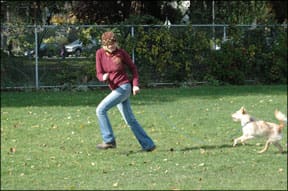
I’ve been blessed throughout much of my life with dogs who have had naturally solid recalls. Maybe it’s due to my predilection for herding breeds, who seem to have a genetically programmed tendency to stick close to their humans. But then there was Josie, the best dog ever, a terrier-mix who never once entertained a “run away” notion during her 15 years as a beloved member of our family.
Still, I don’t think it’s a coincidence that on our farm, Lucy the Corgi and Missy the Australian Shepherd can be off-leash at will, while Dubhy the Scottie and Bonnie the Scottie-mix require closer monitoring. The two terriers have outstanding “situational recalls.” They will both come beautifully sometimes, in some places – not surprisingly, the places we’ve practiced the most – but not with the generalized reliability that Missy and Lucy demonstrate.
I used to teach “Come” the old-fashioned way, in which you put your dog on a sit-stay, walk to the end of the leash, turn, face him, call him, and jerk on the leash. I look back on those days and wonder that we were able to teach recalls that way at all! What a negative association those dogs must have had with the come cue: “Come means run to my owner fast so I don’t get hurt.” Not to mention that to a dog, the body language of a direct frontal position is assertive and intimidating, a position that threatens, “You may be risking bodily harm if you approach.” Yikes! Now I know why Marty, my tricolor obedience competition Collie, always trotted to me with his head down when I called him. He always came, but he wasn’t happy about it. “Workmanlike,” I think the judges called it then.
My Bull Terrier took it one step further. As long as Caper was within the 30-40 foot distance that we practiced for show-ring recalls, her “Come” response was faster than a speeding bullet. But if she was beyond range of my normal leash or long-line correction distance, my “Come!” cue caused her to run as fast, or faster – in the opposite direction.
Teaching happy recalls
We’ve raised the standard since those obedience days some 30-plus years ago. Nowadays we want recalls that are not just reliable, but that are happy and fast as well. We want dogs who come because they want to and love it, not because they have to.
The good news is it’s not as hard as you might think. It just takes a commitment to regular practice, keeping it fun and happy.
• Start by “charging” your “Come” cue. This will be a word that will always mean to your dog: “Absolutely wonderful stuff is about to happen and you better get over here fast or you’re going to miss out!” Say “Come!” in a loud, cheerful voice and feed your dog a very high-value treat – chicken, steak, whatever he thinks is totally wonderful. Repeat many times, until your dog’s eyes light up when he hears the cue. Remember, he doesn’t have to “come” for this part – he’s just hanging out with you, eating treats.
Note: If you’ve already taught your dog that “Come!” sometimes means “bad stuff” then you’ve “poisoned” your cue, and you need to pick a different word. See “The Poisoned Cue” on the next page.
• Now, with your dog walking by your side on leash, say “Come!” loudly, in a cheerful tone of voice, and run away fast. You and your dog are running together, in the same direction. Run 10-15 feet. Reward him with a treat when you stop, or even better, a toy – play a quick game of “Tug” or toss a ball for him to catch. If you keep your rewards high-value and unpredictable, your dog will find your recalls irresistible. “I wonder what exciting thing she’s going to do next!”
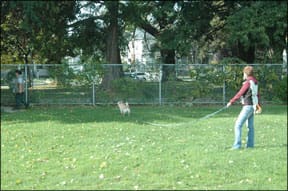
By the way, “fast” is relevant. If you have a Labrador Retriever, “fast” is probably “fast as you can.” If you have a Yorkshire Terrier, “fast” is considerably slower. “Fast” should only be as fast as your dog can comfortably run.
• After several days of practicing the previous steps, try this: Wait until your dog is a few feet away from you (still on leash). Say “Come!” (cheerful and loud!) and run away fast. Run 10-15 feet and reward her at the end. Exciting and unpredictable! If your dog stays very close to you, drop a few yummy treats on the ground, walk to the end of the leash, wait until she’s eating the last one, then say “Come!” and run away. Practice this step for a week or more.
• When your dog consistently runs to you and with you when you say “Come!” and run, start a little off-leash work in a safely enclosed, low-distraction area, such as a hallway in your house, or large den. When he’s not right next to you and not deeply engrossed in some highly rewarding activity (such as gnawing on a bone), say “Come” (loud and cheerful) and run away. Remember to reinforce with an exciting, unpredictable toy or several treats when he comes.
• Avoid calling your dog when he’s not likely to come! At best, you’ll teach him “learned irrelevance” – that your recall cue is meaningless. At worst, you’ll get angrier and more insistent with your recall cue and poison it. Then you’ll have to pick a new cue and start over again. Make sure you have his attention before you call him. Say his name first and wait for him to look at you. If you call him and he doesn’t come, do something else: make a kissy noise or squeak a squeaky toy, and make sure you have his undivided attention before you call him again.
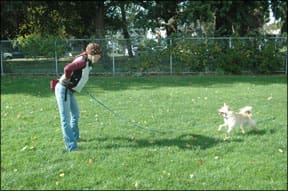
• You can practice longer distance recalls outside with your dog on a long line – a leash that is 20 to 50 feet long (not a retractable leash!). The long line keeps him safe and prevents him from leaving, but do not use it to pull him to you. Remember to turn and run away fast – at least at first. If he’s now flying to you happily every time, you can face him to greet him and reward him when he gets to you.
• When he reliably comes to you on the long-line in a safely enclosed location, start working on off-leash recalls – still in your safely enclosed location. Repeat the two previous steps. Take care not to call him if he’s involved in some highly rewarding activity such as eating deer poop in the garden. Always call him in a loud, cheerful tone, and use a high-value (and unpredictable) reward when he comes.
• When your dog will run happily to you even when you take only one or two running steps, you can add an automatic sit. This parks him when he gets to you.
If you’ve already done a good job of installing a “default sit” by reinforcing “sit” so much that he offers it easily and automatically, this part is easy. As he runs toward you, turn to face him, and when he gets to you pull your shoulders back, lift your chest and, if necessary, raise your hands to your chest. This body language will often elicit a sit. If he sits, reward him. If he doesn’t sit, reward him anyway for coming, and then ask for a sit.
• When your dog’s recall-sits happen easily and automatically, occasionally reach for his collar, gently, under the chin. Give him a yummy treat, and then toss a ball or toy for him to chase. This teaches him to happily accept you reaching for him after a recall for those occasions when you need to restrain him. We’ve all seen those dogs who dance just out of reach when their owners are trying to capture them. Don’t let that be your dog!
• Now you can add Round Robin Recalls with other family members and friends. Supply each player with a stock of toys and yummy treats. Take turns calling your dog and running away fast, with each person rewarding him each time they call him, with a high value (unpredictable and exciting) treat or fun game with a toy.
• As long as your friends and family are around to help with your training, ask them to create distractions while you call your dog. Small ones at first – standing between you and your dog; walking across his recall path; talking to him as he runs by – and then bigger ones: sitting on the ground between you and your dog; holding treats in their hands (but not letting him have them); holding a toy, eventually tossing it in the air and catching it as you call your dog – and finally, huge ones: running across his recall path; throwing a ball on the ground as he runs past; or walking across the yard with another dog on-leash.
What should you do if your dog fails to resist the temptation to investigate one of the distractions? First, try to stop him from engaging with the distraction (the other dog, a ball, another person with treats), put your dog back on-leash, and make a note to yourself: your dog is not yet ready for that level of distraction off-leash!
With your dog back on-leash, go back to work, but with a less-challenging distraction. Ask your distraction volunteers to stand farther away, or to be much less exuberant in their efforts to distract your dog. Also, increase the value of your reinforcer. Bring out the very top-level treats you possess, or the toy that your dog loves so much that it will overcome almost any distraction.
Your goals, as always, are to prevent the dog from being reinforced for behaviors you don’t want (failing to come to you); and to reinforce the behavior you do want (coming when called) with rewards that are very meaningful to your dog (not just kibble).
• If you and your dog have been successful at the previous steps, you can start working on generalizing your dog’s recalls in new locations. Each time you go to a new place, practice recalls on the long line until you’re sure he’s really reliable, even in the presence of big distractions. When you’re confident he’ll come every time you call, and as long as it’s legal and safe, you’re ready for long off-leash hikes in the hills – the best adventure and exercise any dog could ask for.
You may be surprised!
Sometimes our dogs are better than we think they are. While Dubhy’s and Bonnie’s recalls aren’t as solid as Lucy’s and Missy’s, I am sometimes reminded that they’re pretty decent after all. When we hike on the farm, I do let Bonnie off-leash. She bolts off after a flock of crows and I watch her disappear into a hayfield. Since our house in the middle of 80 acres surrounded by neighbors’ woods, I’m not too concerned that I can’t stop her in her tracks and that she ranges a little farther than I’m truly comfortable with. I give her several minutes of running time, then call her. Sure enough, her happy panting face soon peeks out from the tall grass, and we hike on.
Dubhy the Scottie stays on his long-line for our hikes and we practice safe recalls a lot. I know from experience that his recall is great unless he’s halfway down a groundhog hole where he might choose to stay for quite some time.
However, his recall worked like a charm this past July when he discovered a gate he could pry open in the backyard and he escaped into the darkness. When I called the dogs in from their final evening potty-break, Dubhy was nowhere to be found. I grabbed a flashlight and headed out to hunt for him in the woods, knowing how futile it would be to look for a small black dog in the dark, especially if he was down a groundhog hole. I anticipated sitting up all night, going out every 15 minutes to call him, hoping he’d stay out of trouble.
To my surprise and delight, I hadn’t even gotten to the woods when I heard doggie paws rustling through the horse pasture. It was Dubhy, speeding happily back to me in response to his “Come!” cue. Our long-line practice recalls on all our hikes paid off. I’m half-tempted to let him off-leash on our next farm-hike!
Thanks to Sandi Thompson, CPDT, owner of BravoPup! of Berkeley, California, for demonstrating these techniques. See “Resources,” page 24, for contact information.
Pat Miller, CPDT, is Whole Dog Journal’s Training Editor. Miller lives in Hagerstown, Maryland, site of her Peaceable Paws training center. Pat is also author of The Power of Positive Dog Training; Positive Perspectives: Love Your Dog, Train Your Dog; Positive Perspectives II: Know Your Dog, Train Your Dog; and the brand-new Play with Your Dog. See “Resources,” page 24, for more information.


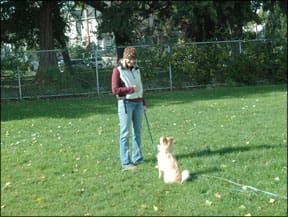
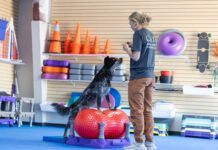


Hi Pat – I wonder if you would expand your thought on “turn and run” why is that a necessary part of learning “come”, I don’t quite understand. Thank you! Julia
Thank you for this detailed article Pat! I have same question as Julia Laird and also another: should you teach 3 different commands for the 3 basic situations where we would use recall?: 1) a quiet “come here sweetie” when at home and you just want to cuddle your dog (so, optional for the dog) 2) the one you describe- the loud, happy “Come!” for all basic recall in fields, etc. And lastly, a total emergency recall for say, running toward something dangerous: “COME!!!!!!!” in a loud and panicked voice ( since that’s probably what we’d use in that situation) charged with some absolutely incredible thing (though how to practice so your neighbors don’t think you’re insane). Just thinking about this since this command involves more scenarios than others such as ‘sit’, or ‘down”. I’ve wondered this same thing about walking on lead. Three different commands for LONG lead outings, 6 ft. lead walking and very close heel. I’m just learning so I very possibly have no clue! 😄 Thanks!!
Great info thank you! Will definitely incorporate with my next pup!
With my last couple of German Shepherds I incorporated two unusual treat trained commands. 1st was:
“Jax-Standby” this worked well when I wanted him to temporarily wait until I got his leash or put on my jacket, grabbed the flashlight , forgot my phone or keys, cleared his spot in the car or any temporary situation where we would momentarily separate until ready to move on as opposed to a bunch of confusing words like hang on-wait a minute-calm down-wait I’ll be right back… He knew “standby” was temporary as opposed to “stay” causing him to wonder if our walk or car ride was not happening or I was leaving without him. The “standby” command actually excited him into complying because he new we were still headed out together after a slight delay or brief separation. Later treats were no longer necessary because the reward was heading out on our next adventure!
The 2nd command was “Hold!”
Used off leash or on leash close or far. This worked well when leashing up a very excited 115 pound German Shepherd before exiting the car, or on our walks off leash when there was something about to occur that could compromise his safety: (live in southern AZ) snake in the grass, scorpion crossing his path, swarm of bees nearby, broken glass, giant ant mound, fire ants, a diseased looking mud puddle or other dangerous debris in his path- not wanting him to move an inch until I could move in and assess things, re-route and or re-leash him as opposed to a recall that could jeopardize her safety or mine. This also worked well when entering or exiting the back yard, the house, again the car or waiting until I stepped through the doorway first etc. or on leash it might be at a busy intersection, or to temporarily stop the walk while chatting with a neighbor or something similar. Once again eager to comply because it was temporary! (The “Stay” command was more of a permanent situation).
Family members hearing and watching these successful commands the first time usually facilitated the deer in the headlights look or comments like whaaaaat??? from them especially those that were themselves a dog owner. I will admit it made me and my giant 4 legged hairy Pal feel kinda special!
Happy New Year!!! JB